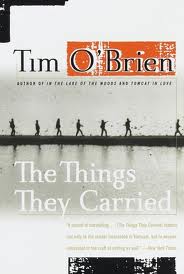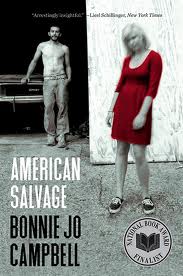
The Things They Carried by Tim O’Brien. New York: Houghton Mifflin, 1990. Review by Sharon Harrigan
One of the great pleasures of this book is implied in its title: lists of objects. Almost always they are a collection of concrete and practical things, like safety pins and insecticide. The lists can go on for four or five lines, gaining speed and breadth.
With the accumulation of real things and a barrage of specific sensory details, (e.g. “he would sometimes taste the envelope flap, knowing her tongue would be there”) O’Brien earns the right to offer a few choice abstractions or metaphors. When he finally writes “they carried their own lives,” it feels inevitable as just as real as everything else in the list.
I had read the title story before; reading it again was a revelation. The lyrical expansiveness of the multitude of lists seemed both illicit (breaking rules for economical writing) and Biblical (like the strings of who begat whom in the Old Testament). These lyrical riffs, these poetic and Walt Whitman-like digressions, puzzled and inspired me. Are fiction writers allowed to do that? I wanted to know. The answer is yes, if you can do it like Tim O’Brien.
But I don’t think the lists and lyrical digressions would work without the skeleton of forward-moving plot holding the story up. The lesson: You can have riffs if you also have momentum, and one way to do both is to alternate as O’Brien does. Part of the story is a specific incident in time leading up to Ted Lavender’s death, and that plot alternates with the part of the story that describes habitual actions, not grounded in a specific time.
I had read the story in an anthology and was impressed by the use of a sustained trope and parallel, repetitive structure, which seemed like the architecture of a poem. The second time, the poetic structure was even clearer. It reminded me of Allen Ginsberg’s long-lined lists but also of a more traditional form, like a sestina, with its repetition of ending words. I can’t remember reading another story with both so daring and meticulous.
“On the Rainy River”
Although the title story is the most anthologized, there is much to learn from the other stories, as well. In “On the Rainy River,” O’Brien uses precise sensory details to win our trust. For example, when he makes general statements like “It was not pleasant work” (about the pig processing factory) we believe him because of the details. Then, after a page of describing exactly what his job was he earns the right to say that after he got his draft notice in the mail, his “life seemed to be collapsing toward slaughter.” This abstraction and summation works because it is held up by the skeleton of precise, concrete details.
O’Brien uses lists to give a comic, manic effect, like the lists of people responsible for the U.S. getting into an amoral war: “All of them–I held them personally and individually responsible–the polyestered Kiwanis boys, the merchants and farmers, the pious churchgoers, the chatty housewives, the PTA and the Lions club and the Veterans of Foreign Wars and the fine upstanding gentry out at the country club.” Then he lets the concrete lead us into the abstract: “I headed straight west along the Rainy River, which separates Minnesota from Canada, and which for me separated one life from another.”
When the narrator tells us he is longing for a life that doesn’t include being sent off to war, he gives us objects to explain what kind of life he wants: “All I wanted was to live the life I was born to . . . I loved baseball and hamburgers and cherry Cokes.” Those objects give us more feeling of longing than a whole paragraph of abstractions and generalizations would.
O’Brien uses his skill for specific detail in his portraits of people. For instance, when the narrator first meets Elroy Berdahl (the man who “saves his life”) we are presented with the kind of details that make him seem real: “He wore a flannel shirt and brown work pants. In one hand, I remember, he carried a green apple, a small paring knife in the other. His eyes had the bluish gray color of a razor blade, the same polished shine.” Then O’Brien earns the right to give us something abstract, a little metaphor: “As he peered up at me I felt a strange sharpness, almost painful, a cutting sensation, as if his gaze were somehow slicing me open.”
At the climax — when the narrator is in the boat with the old man and has to decide whether to jump in the water and swim to Canada, dodging the draft–the lists starts to explode and break all rules of plausibility. The tone—frantic and dangerous—matches the mood of irrevocable decision-making. The narrator is about to die in a way: he has two selves as possibilities, and by choosing one only, the other will die.
The story starts to read like the proverbial moment before death when people can see their whole life flash before their eyes; the narrator can even see his future and the past before he was born. He saw “everybody screaming from the sidelines, rooting [him] on.” He gives us enough sensory details–the popcorn smells, and cheerleaders’ smooth, brown thighs—that the scene becomes real. Then he sees Abraham Lincoln and Saint George, “and several members of the United States Senate . . . and all the dead soldiers back from the grave, and the many thousands who were later to die.” Once he has our credibility, the prose becomes more and more fantastical.
This scene goes on for a page and a half, opening up into more magic and dream logic. The use of so many words, so many images and sensations and time periods, has the effect of slowing down the climax so that we experience how much time slowed down for the narrator. The moments last forever, as we wonder if the narrator will flee to Canada or not.
“Rainy River,” like the title story, is a tour de force of varying rhythms. O’Brien alternates short, staccato, matter-of-fact sentences with strings of long, complex lists of objects, starting simple and plausible and visual, and becoming more absurd. For instance, after the long-winded and explosive lists at the climax, the story ends simply with short, simple words and phrases: “I survived, but it’s not a happy ending. I was a coward. I went to war.” The last three sentences are a summation, though they turn the traditional war story on its head. We expect to be told that people who don’t go to war are the cowards. The surprise of the sentence structure mimics the surprise of their message.
The varying rhythm works in the book as a whole. Long, complex, lyrical stories are often followed by short snips of stories. For example, “The Things They Carried” the first story, weighs in at 26 pages, but it is followed by “Love” (3 pages) and “Spin” (7 pages)–lighter in tone, as well, and more conversational. “On the Rainy River,” one of the morally heftiest stories of the book, is also one of the longest, at 20 pages, followed by two extremely short ones: “Enemies” and “Friends” (2 pages each), both of which are anecdotal with twists at the end.
O’Brien also uses repetition of beginning phrases in sentences to give a poetic cadence and insistence, for instance: “They didn’t know Bao Dai from the man in the moon. They didn’t know history. They didn’t know the first thing about Diem’s tyranny, or the nature of Vietnamese nationalism, or the long colonialism of the French–this was all too damned complicated, it required some reading–but no matter, it was a war to stop the Communists, plain and simple, which was how they liked things, and you were a treasonous pussy if you had second thoughts about killing or dying for plain and simple reasons.” The two short sentences are followed by a very long one, with digressions and dashes, like the first two were just winding up to give the third its power.
“The Man I Killed”
Many of the stories use visual details that make us feel as if we are watching a movie and can see all the close-ups. For instance, “The Man I Killed” starts with a long paragraph visually describing the man. The first sentence is an eight-line-long list of physical features separated just by commas and ending: “his neck was open to the spinal cord and the blood there was thick and shiny and it was this wound that had killed him.” The effect of this nonstop sentence is to make us feel the adrenaline pumping in the narrator’s brain, the speedy, surrreal quality of the experience.
Fiction vs. Memoir and the Meta-Life of the Story
Part of what’s interesting about this book is the way it tries to blur the feeling of memoir with fiction. When I read the first story, “The Things They Carried,” I felt completely enveloped in the artifice of fiction. The structure is so intricate and symmetrical, it felt almost like a poem in its repetition, digressions, symmetry and musicality, that I just wanted to admire it as a man-made thing. Of course, the specificity of the information gave the writing the confidence that makes it sound true, but I assumed it was fiction.
However, the second story, “Love,” is written with the tropes of memoir, starting: “Many years after the war Jimmy Cross came to visit me at my home in Massachusetts, and for a full day we drank coffee and smoked cigarettes and talked about everything we had seen and done so long ago.” Then in the middle of the story, the narrator asks Jimmy Cross’s permission to write his story (to write what Tim O’Brien wrote in the first story). The narrator even has the author’s name.
Jimmy Cross gives Tim permission but tells him not to write about anything embarrassing. Tim agrees, but the reader knows the in-joke, that he did not keep his promise, because we have already read the first story, in all its embarrassing glory. At this point, I flipped to the copyright page and checked the statement that all the characters in this book are fictional. It was a nimble trick for the author to make it seem so much like memoir when it isn’t.
In “How to Tell a True War Story,” the meta-life of the story deepens. The first sentence is “This is true.” The fact that he has to say that makes me suspicious. It’s a trick. He’s planning on my confusion, my desire to know if this book is fictional or not. He’s laughing at me.
In this story, I find out that “true” doesn’t necessarily mean something really happened. Now I am getting somewhere. True means that it conveys the spirit of the experience. O’Brien gives us two counterintuitive examples, one of “a true story that never happened”–something he made up but that gives the essence of what the war was like. (A guy jumps on a mine to take the blast for the three other guys he’s with, but it’s a killer grenade and everybody dies anyway.) He also gives an example of something that actually happened but isn’t true (the same story but the one guy is a dead hero and the other three live): “Even if it did happen. . . even then you know it can’t be true, because a story does not depend upon that kind of truth. Absolute occurrence is irrelevant.”
“How to Tell a True Was Story” also tells us how good, confident writing makes a story true even if it is implausible or impossible. For example, Rat Kiley must have thought it was the sunlight (not a grenade) killing him. “But if I could ever get the story right,” O’Brien the author and Tim the narrator says, “then you would believe.”
“Sweetheart of the Song Tra Bong” is a big, complex story, operatic almost, whose subject is, partly, the rules of writing a good story. For example: exaggeration can make readers feel the truth more than the exact truth would. Rat Kiley tells the often-interrupted story of Mary Ann. Kiley exaggerates, but “it wasn’t a question of deceit. Just the opposite: he wanted to heat up the truth, to make it burn so hot that you would feel exactly what he felt. . . Facts were formed by sensations, not the other way around.”
This story, because much of it is in Kiley’s voice, has more colloquial, colorful phrases, like “A real tiger. D-cup guts, trainer-bra brains.” At important intersections in the story, Rat Kiley pauses and welcomes participation. For instance, he asks Mitchell Sanders to guess where Mary Ann was when she didn’t come back for the night the first time. Mitchell guesses that she’s with the Green Berets, explaining: “No other option. . . That’s how stories, work, man.” The effect of these street-talking soldiers discussing the mechanics of fiction writing is funny. I was delighted to be in on the joke.
This paragraph is something that could benefit all writers, beginners especially: “Whenever he told the story, Rat had a tendency to stop now and then, interrupting the flow, inserting little clarifications or bits of analysis and personal opinion. It was a bad habit, Mitchell Sanders said, because all that matters is the raw material, the stuff itself, and you can’t clutter it up with your own half-baked commentary. That just breaks the spell. It destroys the magic. What you have to do, Sanders said, is trust your own story. Get the hell out of the way and let it tell itself.” This advice is especially helpful for war stories, when there is such a temptation to give it a cautionary or uplifting moral.
At the next pause, Rat Kiley says he was redeployed and didn’t know what happened to Mary Ann next. Sanders responds: “You can’t say . . . I don’t know the ending. . . you got a certain obligation.” If this were memoir, he would stop there, but luckily we are in fiction, and even the fictional characters know that for the rest of that story, he’ll give them hearsay, speculation, and beyond.
O’Brien’s characters offer much more on the process of writing, like this gem: “By telling stories, you objectify your own experience. You separate yourself. You pin down certain truths. You make up others.” This is the practical pointer I found useful: “You start sometimes with an incident that truly happened, like the night in the shit field, and you carry it forward by inventing incidents that did not in fact occur but that nonetheless help to clarify and explain.”
In “Notes” O’Brien describes how he wrote the story “Speaking of Courage”: “To provide a dramatic frame, I collapsed events into a single time and place, a car circling a lake on a quiet afternoon in midsummer, using the lake as a nucleus around which the story would orbit.” The idea of collapsing time for simplicity, clarity, and emphasis and inventing a natural counterpoint and metaphor unity is good advice for fiction writers.
The Things They Carried has much to offer and I would recommend it to any reader: a profound topic (the morality of war and what it’s like to live always on the brink of death), complex story structure and artful language, and a practical discourse on how to write. The two most practical lessons I have already started to use in my writing are pay attention to variation of sentence length and use concrete objects and specific, sensory detail to earn the occasional use of abstractions.

